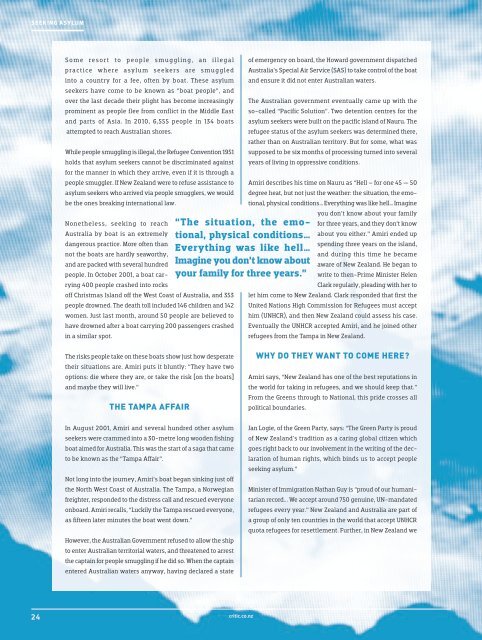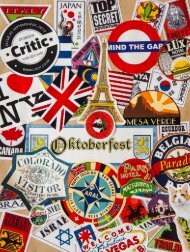You also want an ePaper? Increase the reach of your titles
YUMPU automatically turns print PDFs into web optimized ePapers that Google loves.
sEEKiNG AsYLUM<br />
24<br />
Some resort to people smuggling, an illegal<br />
practice where asylum seekers are smuggled<br />
into a country for a fee, often by boat. These asylum<br />
seekers have come to be known as “boat people”, and<br />
over the last decade their plight has become increasingly<br />
prominent as people flee from conflict in the Middle East<br />
and parts of Asia. In 2010, 6,555 people in 134 boats<br />
attempted to reach Australian shores.<br />
While people smuggling is illegal, the Refugee Convention 1951<br />
holds that asylum seekers can<strong>not</strong> be discriminated against<br />
for the manner in which they arrive, even if it is through a<br />
people smuggler. If New Zealand were to refuse assistance to<br />
asylum seekers who arrived via people smugglers, we would<br />
be the ones breaking international law.<br />
Nonetheless, seeking to reach<br />
Australia by boat is an extremely<br />
dangerous practice. More often than<br />
<strong>not</strong> the boats are hardly seaworthy,<br />
and are packed with several hundred<br />
people. In October 2001, a boat carrying<br />
400 people crashed into rocks<br />
off Christmas Island off the West Coast of Australia, and 353<br />
people drowned. The death toll included 146 children and 142<br />
women. Just last month, around 50 people are believed to<br />
have drowned after a boat carrying 200 passengers crashed<br />
in a similar spot.<br />
The risks people take on these boats show just how desperate<br />
their situations are. Amiri puts it bluntly: “They have two<br />
options: die where they are, or take the risk [on the boats]<br />
and maybe they will live.”<br />
THe TAmpA AffAir<br />
In August 2001, Amiri and several hundred other asylum<br />
seekers were crammed into a 30-metre long wooden fishing<br />
boat aimed for Australia. This was the start of a saga that came<br />
to be known as the “Tampa Affair”.<br />
Not long into the journey, Amiri’s boat began sinking just off<br />
the North West Coast of Australia. The Tampa, a Norwegian<br />
freighter, responded to the distress call and rescued everyone<br />
onboard. Amiri recalls, “Luckily the Tampa rescued everyone,<br />
as fifteen later minutes the boat went down.”<br />
However, the Australian Government refused to allow the ship<br />
to enter Australian territorial waters, and threatened to arrest<br />
the captain for people smuggling if he did so. When the captain<br />
entered Australian waters anyway, having declared a state<br />
“The situation, the emotional,<br />
physical conditions…<br />
Everything was like hell…<br />
Imagine you don’t know about<br />
<strong>your</strong> family for three years.”<br />
critic.co.nz<br />
of emergency on board, the Howard government dispatched<br />
Australia’s Special Air Service (SAS) to take control of the boat<br />
and ensure it did <strong>not</strong> enter Australian waters.<br />
The Australian government eventually came up with the<br />
so-called “Pacific Solution”. Two detention centres for the<br />
asylum seekers were built on the pacific island of Nauru. The<br />
refugee status of the asylum seekers was determined there,<br />
rather than on Australian territory. But for some, what was<br />
supposed to be six months of processing turned into several<br />
years of living in oppressive conditions.<br />
Amiri describes his time on Nauru as “Hell – for one 45 — 50<br />
degree heat, but <strong>not</strong> just the weather: the situation, the emotional,<br />
physical conditions… Everything was like hell… Imagine<br />
you don’t know about <strong>your</strong> family<br />
for three years, and they don’t know<br />
about you either.” Amiri ended up<br />
spending three years on the island,<br />
and during this time he became<br />
aware of New Zealand. He began to<br />
write to then-Prime Minister Helen<br />
Clark regularly, pleading with her to<br />
let him come to New Zealand. Clark responded that first the<br />
United Nations High Commission for Refugees must accept<br />
him (UNHCR), and then New Zealand could assess his case.<br />
Eventually the UNHCR accepted Amiri, and he joined other<br />
refugees from the Tampa in New Zealand.<br />
WHy do THey WAnT To come Here?<br />
Amiri says, “New Zealand has one of the best reputations in<br />
the world for taking in refugees, and we should keep that.”<br />
From the Greens through to National, this pride crosses all<br />
political boundaries.<br />
Jan Logie, of the Green Party, says: “The Green Party is proud<br />
of New Zealand's tradition as a caring global citizen which<br />
goes right back to our involvement in the writing of the declaration<br />
of human rights, which binds us to accept people<br />
seeking asylum.”<br />
Minister of Immigration Nathan Guy is “proud of our humani-<br />
tarian record... We accept around 750 genuine, UN-mandated<br />
refugees every year.” New Zealand and Australia are part of<br />
a group of only ten countries in the world that accept UNHCR<br />
quota refugees for resettlement. Further, in New Zealand we














